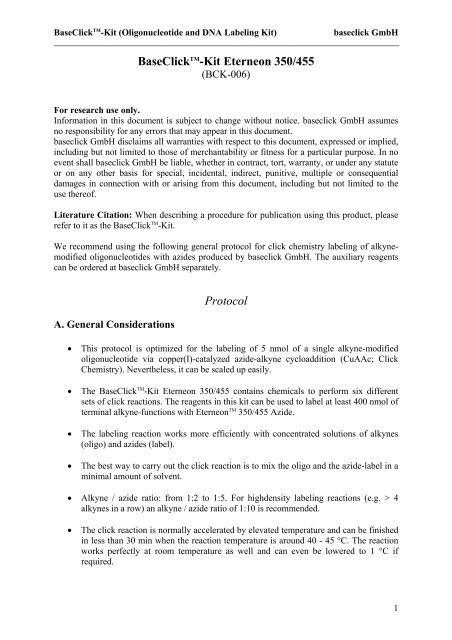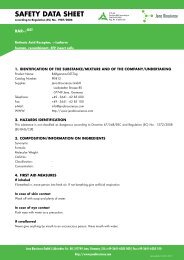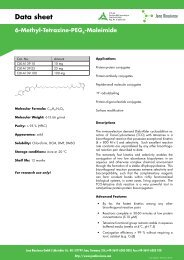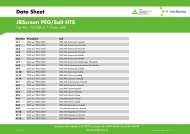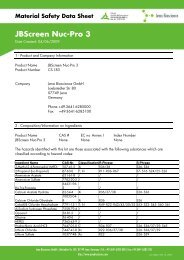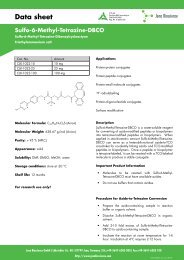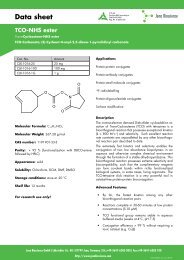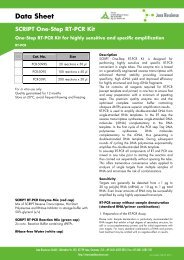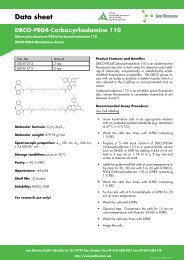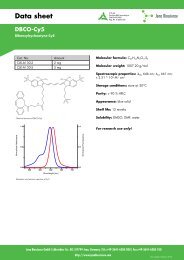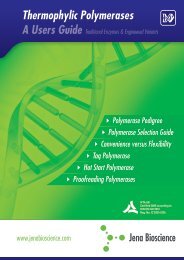BaseClickTM-Kit Eterneon 350/455 Protocol - Jena Bioscience
BaseClickTM-Kit Eterneon 350/455 Protocol - Jena Bioscience
BaseClickTM-Kit Eterneon 350/455 Protocol - Jena Bioscience
You also want an ePaper? Increase the reach of your titles
YUMPU automatically turns print PDFs into web optimized ePapers that Google loves.
BaseClick TM -<strong>Kit</strong> (Oligonucleotide and DNA Labeling <strong>Kit</strong>)<br />
baseclick GmbH<br />
___________________________________________________________________________________________<br />
BaseClick TM -<strong>Kit</strong> <strong>Eterneon</strong> <strong>350</strong>/<strong>455</strong><br />
(BCK-006)<br />
For research use only.<br />
Information in this document is subject to change without notice. baseclick GmbH assumes<br />
no responsibility for any errors that may appear in this document.<br />
baseclick GmbH disclaims all warranties with respect to this document, expressed or implied,<br />
including but not limited to those of merchantability or fitness for a particular purpose. In no<br />
event shall baseclick GmbH be liable, whether in contract, tort, warranty, or under any statute<br />
or on any other basis for special, incidental, indirect, punitive, multiple or consequential<br />
damages in connection with or arising from this document, including but not limited to the<br />
use thereof.<br />
Literature Citation: When describing a procedure for publication using this product, please<br />
refer to it as the BaseClick TM -<strong>Kit</strong>.<br />
We recommend using the following general protocol for click chemistry labeling of alkynemodified<br />
oligonucleotides with azides produced by baseclick GmbH. The auxiliary reagents<br />
can be ordered at baseclick GmbH separately.<br />
A. General Considerations<br />
<strong>Protocol</strong><br />
• This protocol is optimized for the labeling of 5 nmol of a single alkyne-modified<br />
oligonucleotide via copper(I)-catalyzed azide-alkyne cycloaddition (CuAAc; Click<br />
Chemistry). Nevertheless, it can be scaled up easily.<br />
• The BaseClick TM -<strong>Kit</strong> <strong>Eterneon</strong> <strong>350</strong>/<strong>455</strong> contains chemicals to perform six different<br />
sets of click reactions. The reagents in this kit can be used to label at least 400 nmol of<br />
terminal alkyne-functions with <strong>Eterneon</strong> TM <strong>350</strong>/<strong>455</strong> Azide.<br />
• The labeling reaction works more efficiently with concentrated solutions of alkynes<br />
(oligo) and azides (label).<br />
• The best way to carry out the click reaction is to mix the oligo and the azide-label in a<br />
minimal amount of solvent.<br />
• Alkyne / azide ratio: from 1:2 to 1:5. For highdensity labeling reactions (e.g. > 4<br />
alkynes in a row) an alkyne / azide ratio of 1:10 is recommended.<br />
• The click reaction is normally accelerated by elevated temperature and can be finished<br />
in less than 30 min when the reaction temperature is around 40 - 45 °C. The reaction<br />
works perfectly at room temperature as well and can even be lowered to 1 °C if<br />
required.<br />
1
BaseClick TM -<strong>Kit</strong> (Oligonucleotide and DNA Labeling <strong>Kit</strong>)<br />
baseclick GmbH<br />
___________________________________________________________________________________________<br />
• The reaction time depends on: a) concentration of azide and oligo in the solution;<br />
b) reaction temperature; c) stirring and/or mixing of the solution.<br />
• Excess of reagents are normally removed by ethanol precipitation of the labeled<br />
oligonucleotide.<br />
B. Materials provided with the <strong>Kit</strong> and storage conditions<br />
Vialcolour<br />
Amount Component Storage<br />
red 1 mg <strong>Eterneon</strong> TM <strong>350</strong>/<strong>455</strong> Azide 2 dark, -20 °C<br />
yellow 5,4 mg TBTA-Ligand 1, 2 -20 °C<br />
green 6 x 1 mg CuBr 1 dry, inert gas<br />
blue 2 x1 mL DMSO/t-BuOH 1 RT<br />
1 baseclick grade<br />
2 a prepared solution can be stored at - 20 °C in the dark for several months<br />
(Note: The azide functionality is very stable and does not hydrolyze in the presence of water.)<br />
C. Required Material and Equipment<br />
Alkyne-modified oligonucleotide (can be ordered @ baseclick GmbH, Integrated DNA<br />
Technologies, Metabion, IBA or EllaBiotech)<br />
Microcentrifuge<br />
Vortexer<br />
Thermomixer (optional)<br />
Microcentrifuge tubes<br />
Ethanol (5 % Diethylether)<br />
0,3 M Sodium-acetate solution (0,3 M NaOAc)<br />
D. Click-<strong>Protocol</strong> for Oligonucleotide Labeling<br />
1. Before You Start<br />
a) Calculate the total amount of terminal alkyne modifications n in nmol present in your<br />
oligonucleotide:<br />
n = m x y where:<br />
n = terminal alkyne modifications in nmol<br />
m = amount of oligonucleotides in nmol<br />
y = number of terminal alkyne functions in your oligonucleotide<br />
e.g. you have 20 nmol of a triple alkyne modified oligonucleotide:<br />
amount of terminal alkyne modifications n = 20 nmol x 3 = 60 nmol.<br />
2
BaseClick TM -<strong>Kit</strong> (Oligonucleotide and DNA Labeling <strong>Kit</strong>)<br />
baseclick GmbH<br />
___________________________________________________________________________________________<br />
b) Calculate the amount of azide k in nmol required for the labeling of the alkyne-modified<br />
oligonucleotide:<br />
k = n x l where:<br />
k = amount of azide required for labeling in nmol<br />
n = terminal alkyne modifications in nmol<br />
l = azide equivalents (excess of azide: between 2 and 10)<br />
e.g. you have n = 60 nmol of terminal alkyne modifications:<br />
amount of azide k = 60 nmol x 5 = 300 nmol.<br />
2. Preparation of the Oligonucleotide Solution<br />
Dissolve the oligonucleotide in the appropriate amount of water to adjust to 1 mM solution<br />
and centrifuge shortly. (Also different concentrations can be used!).<br />
3. Preparation of a 10 mM <strong>Eterneon</strong> TM <strong>350</strong>/<strong>455</strong> Azide Solution<br />
a) Take the red vial with 1 mg <strong>Eterneon</strong> TM <strong>350</strong>/<strong>455</strong> Azide out of the freezer and slowly warm<br />
up to room temperature.<br />
b) Centrifuge shortly to place all <strong>Eterneon</strong> TM <strong>350</strong>/<strong>455</strong> Azide on the bottom of the vial.<br />
c) Pipette 219 µL of DMSO/t-BuOH-solution (blue vial) into the red vial with <strong>Eterneon</strong> TM<br />
<strong>350</strong>/<strong>455</strong> Azide.<br />
d) Vortex the red vial until the azide is dissolved completely.<br />
e) Centrifuge shortly. This solution can be stored at -20°C in the dark for several months. The<br />
azide functionality is very stable and does not hydrolyze in the presence of water.<br />
4. Preparation of Oligonucleotide / <strong>Eterneon</strong> TM <strong>350</strong>/<strong>455</strong> Azide Solution<br />
a) Prepare a 1,5 mL vial (referred to as reaction vial).<br />
b) Pipette the correct amount of oligonucleotide solution corresponding to 5 nmol of<br />
oligonucleotide into the reaction vial (here: 5 µL of a 1 mM solution).<br />
c) Pipette 2,5 µL of <strong>Eterneon</strong> TM <strong>350</strong>/<strong>455</strong> Azide solution (red vial, 10 mM, 25 nmol, 5<br />
equivalents) directly into the reaction vial with the oligonucleotide.<br />
5. Preparation of the TBTA-Ligand Solution<br />
a) Dissolve the whole content of the yellow vial (TBTA-Ligand) in 100 µL DMSO/t-BuOH<br />
(blue vial). This solution can be stored at -20°C for several months.<br />
3
BaseClick TM -<strong>Kit</strong> (Oligonucleotide and DNA Labeling <strong>Kit</strong>)<br />
baseclick GmbH<br />
___________________________________________________________________________________________<br />
b) If this solution was already prepared, take it out of the freezer and let it defrost. Vortex<br />
shortly and centrifuge.<br />
c) Pipette 10 µL out of the yellow vial into an empty vial (referred to as catalyst vial).<br />
Please notice that the next three steps (6, 7 and 8) have to be performed as<br />
quick as possible!!<br />
6. Preparation of the CuBr Solution<br />
This solution must always be freshly prepared prior to use!<br />
a) Do not open the green vial before using it! CuBr is stored under protective atmosphere<br />
(inert gas, Argon). Centrifuge the green vial shortly to place all CuBr on the bottom of the<br />
vial.<br />
b) Pipette 70 µL DMSO/t-BuOH-solution (blue vial) into the green vial and dissolve the<br />
CuBr completely by vortexing. Centrifuge shortly. Be quick to avoid oxidation of Cu(I)!<br />
Proceed immediately with the next step!<br />
7. Preparation of the Catalyst Solution<br />
This solution must always be freshly prepared prior to use!<br />
Pipette 5 µL of the freshly prepared CuBr solution (green vial, see step 6 b)) into the catalyst<br />
vial with the TBTA-Ligand (see step 5 c)) and vortex for 10 sec. Centrifuge shortly. Be quick<br />
to avoid oxidation of Cu(I)! Proceed immediately with the next step!<br />
8. Performing the Click Reaction<br />
Pipette 1,5 µL of the Catalyst Solution (catalyst vial, see step 7) into the reaction vial<br />
(Oligonucleotide / <strong>Eterneon</strong> TM <strong>350</strong>/<strong>455</strong> Azide Solution, see step 4) and vortex for 10 sec.<br />
Centrifuge shortly and place the reaction vial in a Thermomixer at 37 °C. Shake the reaction<br />
vial for 4 h. (Alternatively the reaction vial can be placed in a warm water bath.)<br />
9. Removal of excess reagents<br />
Add 100 µL of a 0,3 M NaOAc solution and precipitate the oligonucleotide by adding 1 mL<br />
cold ethanol (containing 5 % diethylether; -20 °C). Centrifuge for at least 20 min at 6000 rpm<br />
or higher. Remove the supernatant and wash the residue with 100 µL cold ethanol (containing<br />
5 % diethylether; -20 °C). Centrifuge again for at least 10 min and remove the supernatant.<br />
Dry the residue on air.<br />
4
BaseClick TM -<strong>Kit</strong> (Oligonucleotide and DNA Labeling <strong>Kit</strong>)<br />
baseclick GmbH<br />
___________________________________________________________________________________________<br />
E. Troubleshooting<br />
If significant precipitation of azide or ligand is observed, add additional DMSO/t-BuOHsolution<br />
and/or heat up gently until all components are dissolved completely.<br />
If the Click Reaction was not successful, check your CuBr. If the freshly prepared CuBrsolution<br />
has already a deep brown colour, the CuBr is significantly oxidized. Repeat the<br />
reaction using a new batch of CuBr.<br />
5


